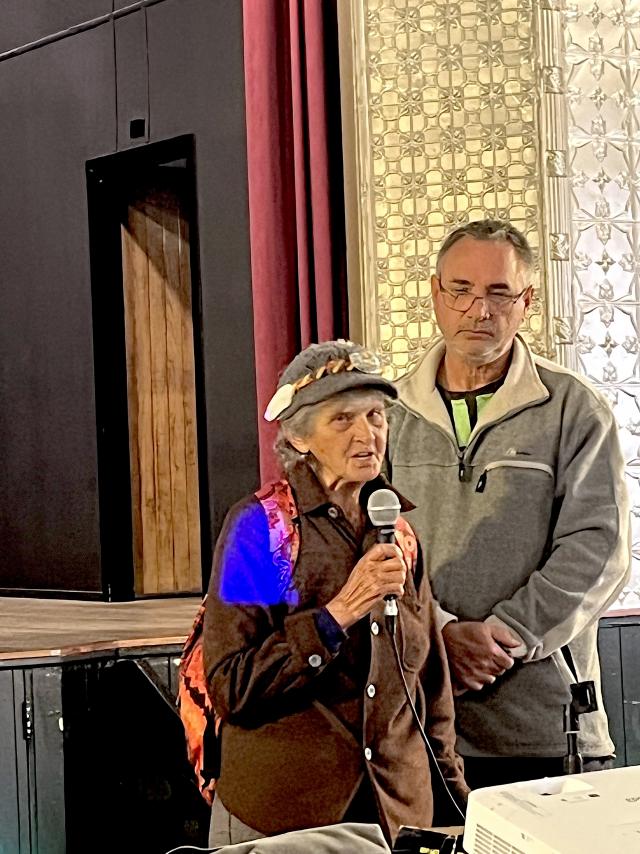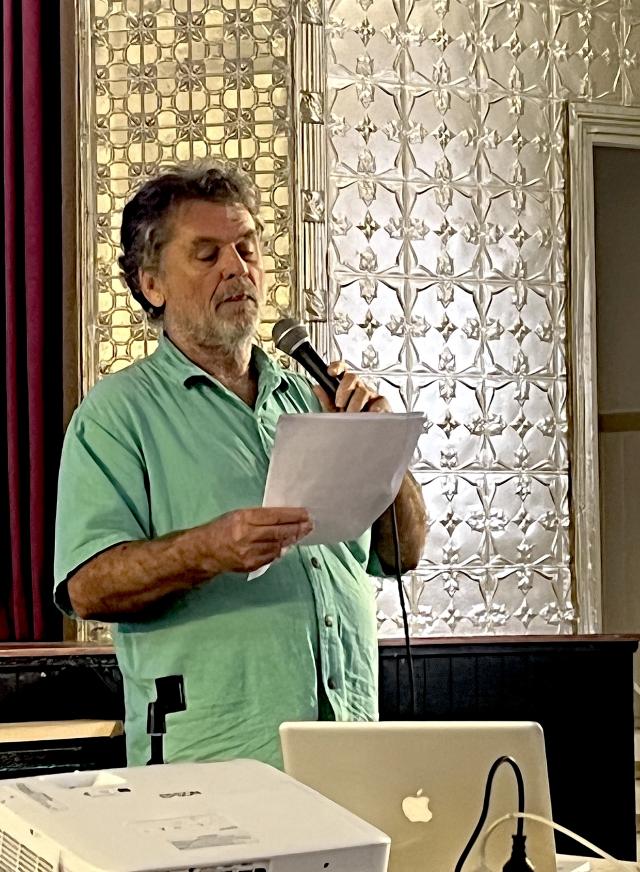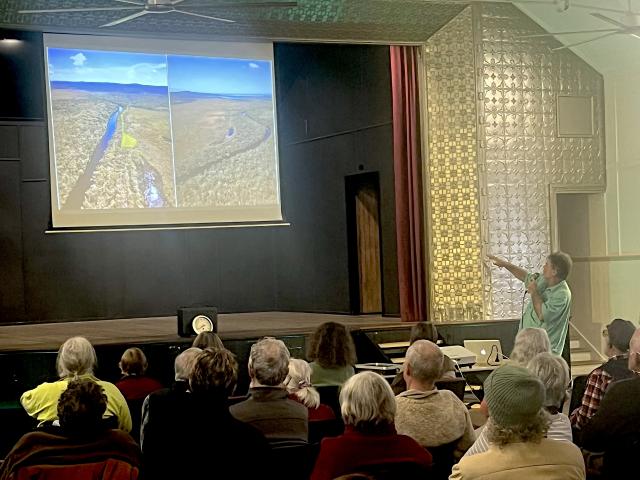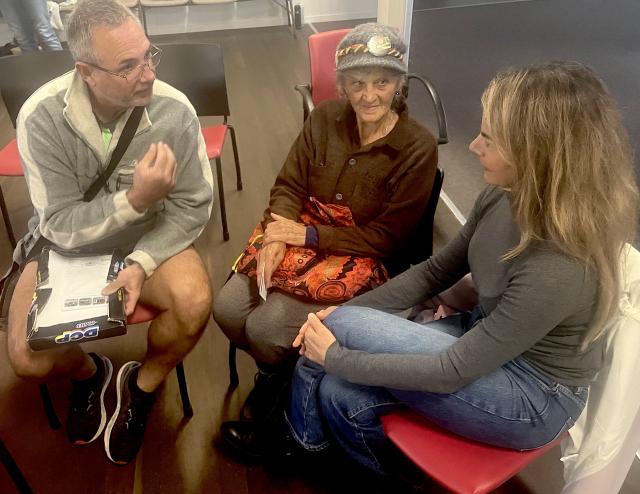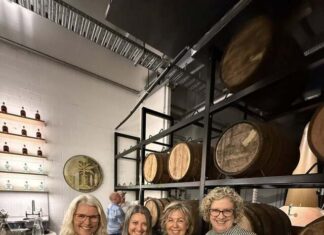More than 100 people braved the weekend wet in Cooroy last Saturday to attend a public forum on the controversial Cooloola Great Walk proposal and hear “some words from Kabi people who haven’t been heard yet”.
Organised by environmental activist groups Protect Our Parks and Keep Cooloola Cool, the forum at Cooroy Memorial Hall devoted the first half of more than three hours to presenting an alternative First Nations view on the project as opposed to that of the elected Kabi Kabi Native Title Claimant Group, who are currently negotiating an Indigenous Land Use Agreement with the Queensland Government to co-manage the building and operation of a commercial “glamping” tourist attraction within the Cooloola Wilderness section of the Great Sandy National Park, in partnership with commercial operator CABN.
Since the project was first announced more than two years ago, it has attracted heavy criticism over its perceived lack of transparency, its economic sustainability, and, most frequently, over whether the Kabi Kabi people really want this to happen on land that will be theirs when the Native Title claim is finalized next April. As co-convenor Greg Wood of Protect Our Parks explained: “We’re devoting a lot of time to the Kabi viewpoint because it’s one of the most important issues of today’s meeting … The other side is relying on acquiescence and cynicism and confusion, so we want all of you to understand it and spread the word and act.”
This was the first of many such calls to action in an afternoon of highly emotive presentations that seemed to hit a chord with the audience, for whom the three-part takeaway might have been: the Great Walk project is being advanced against the wishes of the vast majority of Kabi Kabi people; if it goes ahead it is likely to destroy forever one of the great national parks of the world; and the Queensland Government is colluding with CABN and the seven members of the Kabi Kabi Claimant Group to turn Cooloola into a private profit centre.
While none of the above is true, there are certainly many questions to be asked and answered about the Great Walk, a process which began (and was reported at length in this newspaper) last month at the Australian Institute of Aboriginal and Torres Strait Islander Studies summit at the Sunshine Coast Conference Centre, when Kabi Kabi Native Title Applicant Brian Warner and CABN CEO Michael Lamprell gave the first detailed report on the work in progress for public consumption. As reported, it raised almost as many questions as it answered, but it did reveal that the stakeholders had taken on board community and conservationist concerns and were reviewing such issues as where the camping sites would be situated, the size of their footprints and the impact of access tracks.
The AIATSIS presentation was not mentioned at last Saturday’s forum, and nor was the fact that the sites at Poona Lake and in the Noosa River catchment area and close to the unique fens were being changed. Speaking for the applicants, Brian Warner told Noosa Today he had not been invited to the forum but said that the group was on track to finalise the site choices and step up the next round of Kabi Kabi consultation by September.
Greg Wood’s slide show took the attentive audience on a tour of an earlier version of the proposed campsites and discussed the very real fears of environmental damage to them, but the fact is that the most contentious sites are no longer in the plan.
Wood noted: “Growing numbers within the community are deeply concerned at the State Government’s failure to adequately engage with them upon the core principle of on-park development, and its failure to adequately engage upon and explain critical matters within the proposed development itself. The forum provides an opportunity to hear a summary of public concerns that remain problematically outside of the Government’s range of hearing, and to better understand public sentiment on those matters.”
Keep Cooloola Cool founder Matt Noffke told the forum: “The Kabi Kabi people have been denied the process of consultation on this issue. I began to ask myself, was it incompetence or were they using a piece of legislation to hide behind and keep information from both Indigenous and non-Indigenous people? Why isn’t our government acting honorably over this? Where are the environmental groups and why aren’t they standing up for national parks? How has all of this gone so wrong? Most of the people involved in this project are running around doing deals … that don’t deliver great outcomes, deals between people who have lost their way, and we as a community are supposed to sit back and pretend it’s not happening, that our Great Sandy National Park is not being destroyed by a business model that thrives on segregation … We accept that each of us might have a different opinion on this, but … the project is a farce that does nothing to benefit our community, our environment or our First Nations people.”
The Kabi people “we haven’t heard yet” were represented by Gympie-based elders Wit-booka, Aunty Dawn and a man introduced only as “Darky”, who have been involved in a long battle to protect the sacred site of Djaki Kundu from highway construction. Wit-booka began and ended optimistically and strongly: “We have a magic word called Wirritjin, which means blackfellas and whitefellas working together, and this is what needs to happen … We all need to stand up against these unlawful corporations So we stand with Matt and Greg and all you people in the spirit of Wirritjin, black and white working together to stop them destroying our culture and yours, and our way of life.”
Aunty Dawn, a small, smiling lady, backed him up on this: “We really do appreciate everyone standing with us on this campaign because if we stand together united we’re on a winning track. We appreciate your help in this because if we win, you win.”
Unfortunately, the middle of a forceful presentation went somewhat off topic and devolved into personal attacks on the elected Native Title Claimants and a rambling dissertation about Aboriginal sovereignty since the Bunya Proclamation of 1842. Perplexed about the true message of Mr Wit-booka, I later read the information sheet he was handing out and was led to the website of the Original Sovereign Tribal Federation, where I found most of his source material.
The Original Sovereign Tribal Federation was formed in 2010 by Dunham Badi Jakamarra, a Warlpiri man from the Northern Territory. Its website says it has a treaty with a “large number of tribes” and that it aims to unite the “original society nationally” and “expose the fraud being conducted against the tribes on behalf of the Crown Corporation by its UK and Australian parliaments”. In 2020, the Federation signed a memorandum of understanding with the fledgling Great Australian Party led by former One Nation senator Rod Culleton. Federation members have also been linked with the international Sovereign Citizens movement (“SovCits”), the Australia United Party and various anti-vax and far right groups. Most recently, the Federation was behind the storming of Canberra’s Old Parliament House last December and fire damage to the lobby, an act that was roundly condemned by ACT Indigenous groups and the original Aboriginal Tent Embassy.
It’s difficult to fathom exactly what the OSTF wants but the existing Land Rights Act isn’t part of it, and in our local context, that probably means killing a deal built around it is on their agenda.
Asked to summarise the outcomes after the Cooroy meeting, Greg Wood told Noosa Today: “The meeting conveyed the imperative that the current form and process of the Cooloola Plan must stop, and that the Nature Conservation Act must be reinstated to its original form (pre 2013) as Government cannot be trusted to interpret its current provisions in good faith with the public interest. Meeting participants were encouraged, and were enthusiastic, to share the information and to clearly present their objections upon the current situation to all levels of Government.”
Matt Noffke said: “The forum has reinforced that this proposal is not in the community’s or environment’s interest. It has been developed for commercial enterprise and has no place in our National Parks. Our elected representatives need to do their jobs and stand up for our community, the environmental sector needs to stop doing deals and protect the last remaining unspoilt and un-urbanised landscape we have.”
Noosa Councillor Amelia Lorentson, the lone political representative present, said: “This is highly contentious development and there is a lot at stake, so it’s important to listen to all sides of the argument. You need to understand where the opposition is coming from.”
I’ve spoken at some length to Wood and Noffke about the hard work they’ve put into this campaign, and I know both are genuine about their fears for Cooloola and what they see as the duplicity of government. I know that they also genuinely want to ensure that Kabi Kabi people are presented with the facts so that they can judge the Great Walk project on a truthful assessment, and at the end of the day, it will be a Kabi decision.
But one thing that Greg Wood said in answer to a question about how we could move to stop the project stayed with me: “The best and quickest way to knock it off is to kill the Indigenous Land Use Agreement.” That might be true, but wouldn’t that be Kabi business?
Meanwhile in NSW last weekend environment minister James Griffin announced an expansion of the successful Aboriginal joint-management model of its national parks, aimed at paving the way to transfer the entire estate, which makes up 10 percent of NSW, to traditional owners over the next two decades.

